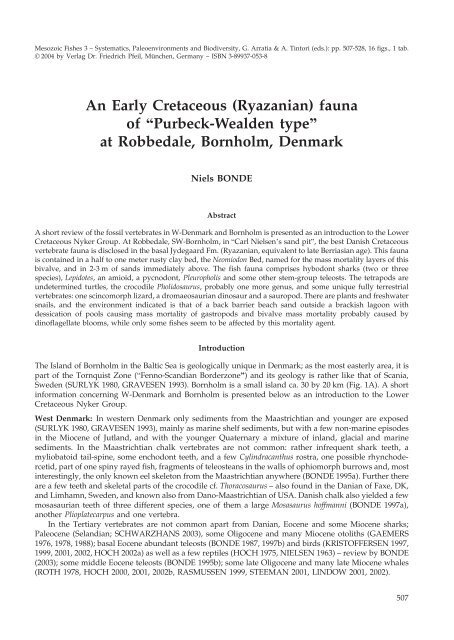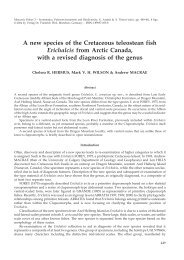An Early Cretaceous (Ryazanian) fauna of “Purbeck-Wealden type ...
An Early Cretaceous (Ryazanian) fauna of “Purbeck-Wealden type ...
An Early Cretaceous (Ryazanian) fauna of “Purbeck-Wealden type ...
You also want an ePaper? Increase the reach of your titles
YUMPU automatically turns print PDFs into web optimized ePapers that Google loves.
Mesozoic Fishes 3 – Systematics, Paleoenvironments and Biodiversity, G. Arratia & A. Tintori (eds.): pp. 507-528, 16 figs., 1 tab.<br />
© 2004 by Verlag Dr. Friedrich Pfeil, München, Germany – ISBN 3-89937-053-8<br />
<strong>An</strong> <strong>Early</strong> <strong>Cretaceous</strong> (<strong>Ryazanian</strong>) <strong>fauna</strong><br />
<strong>of</strong> <strong>“Purbeck</strong>-<strong>Wealden</strong> <strong>type</strong>”<br />
at Robbedale, Bornholm, Denmark<br />
Niels BONDE<br />
Abstract<br />
A short review <strong>of</strong> the fossil vertebrates in W-Denmark and Bornholm is presented as an introduction to the Lower<br />
<strong>Cretaceous</strong> Nyker Group. At Robbedale, SW-Bornholm, in “Carl Nielsen’s sand pit”, the best Danish <strong>Cretaceous</strong><br />
vertebrate <strong>fauna</strong> is disclosed in the basal Jydegaard Fm. (<strong>Ryazanian</strong>, equivalent to late Berriasian age). This <strong>fauna</strong><br />
is contained in a half to one meter rusty clay bed, the Neomiodon Bed, named for the mass mortality layers <strong>of</strong> this<br />
bivalve, and in 2-3 m <strong>of</strong> sands immediately above. The fish <strong>fauna</strong> comprises hybodont sharks (two or three<br />
species), Lepidotes, an amioid, a pycnodont, Pleuropholis and some other stem-group teleosts. The tetrapods are<br />
undetermined turtles, the crocodile Pholidosaurus, probably one more genus, and some unique fully terrestrial<br />
vertebrates: one scincomorph lizard, a dromaeosaurian dinosaur and a sauropod. There are plants and freshwater<br />
snails, and the environment indicated is that <strong>of</strong> a back barrier beach sand outside a brackish lagoon with<br />
dessication <strong>of</strong> pools causing mass mortality <strong>of</strong> gastropods and bivalve mass mortality probably caused by<br />
din<strong>of</strong>lagellate blooms, while only some fishes seem to be affected by this mortality agent.<br />
Introduction<br />
The Island <strong>of</strong> Bornholm in the Baltic Sea is geologically unique in Denmark; as the most easterly area, it is<br />
part <strong>of</strong> the Tornquist Zone (“Fenno-Scandian Borderzone”) and its geology is rather like that <strong>of</strong> Scania,<br />
Sweden (SURLYK 1980, GRAVESEN 1993). Bornholm is a small island ca. 30 by 20 km (Fig. 1A). A short<br />
information concerning W-Denmark and Bornholm is presented below as an introduction to the Lower<br />
<strong>Cretaceous</strong> Nyker Group.<br />
West Denmark: In western Denmark only sediments from the Maastrichtian and younger are exposed<br />
(SURLYK 1980, GRAVESEN 1993), mainly as marine shelf sediments, but with a few non-marine episodes<br />
in the Miocene <strong>of</strong> Jutland, and with the younger Quaternary a mixture <strong>of</strong> inland, glacial and marine<br />
sediments. In the Maastrichtian chalk vertebrates are not common: rather infrequent shark teeth, a<br />
myliobatoid tail-spine, some enchodont teeth, and a few Cylindracanthus rostra, one possible rhynchodercetid,<br />
part <strong>of</strong> one spiny rayed fish, fragments <strong>of</strong> teleosteans in the walls <strong>of</strong> ophiomorph burrows and, most<br />
interestingly, the only known eel skeleton from the Maastrichtian anywhere (BONDE 1995a). Further there<br />
are a few teeth and skeletal parts <strong>of</strong> the crocodile cf. Thoracosaurus – also found in the Danian <strong>of</strong> Faxe, DK,<br />
and Limhamn, Sweden, and known also from Dano-Maastrichtian <strong>of</strong> USA. Danish chalk also yielded a few<br />
mosasaurian teeth <strong>of</strong> three different species, one <strong>of</strong> them a large Mosasaurus h<strong>of</strong>fmanni (BONDE 1997a),<br />
another Plioplatecarpus and one vertebra.<br />
In the Tertiary vertebrates are not common apart from Danian, Eocene and some Miocene sharks;<br />
Paleocene (Selandian; SCHWARZHANS 2003), some Oligocene and many Miocene otoliths (GAEMERS<br />
1976, 1978, 1988); basal Eocene abundant teleosts (BONDE 1987, 1997b) and birds (KRISTOFFERSEN 1997,<br />
1999, 2001, 2002, HOCH 2002a) as well as a few reptiles (HOCH 1975, NIELSEN 1963) – review by BONDE<br />
(2003); some middle Eocene teleosts (BONDE 1995b); some late Oligocene and many late Miocene whales<br />
(ROTH 1978, HOCH 2000, 2001, 2002b, RASMUSSEN 1999, STEEMAN 2001, LINDOW 2001, 2002).<br />
507
The whole contribution can be<br />
purchased as PDF fi le.<br />
Availability<br />
Generally all our publications are available as PDF fi les;<br />
full publications as a general rule after the printed version<br />
is out <strong>of</strong> print. If you have questions concerning particular<br />
contributions please contact us by e-mail:<br />
pdf@pfeil-verlag.de.<br />
The PDF fi les are protected by copyright.<br />
The PDF fi le may be printed for personal use.<br />
The reproduction and dissemination <strong>of</strong> the content or<br />
part <strong>of</strong> it is permitted.<br />
It is not allowed to transfer the digital personal certifi cate<br />
or the password to other persons.<br />
Prices<br />
Books: Prices are to be found in the catalog.<br />
Articles in journals and single contributions or chapters<br />
in books:<br />
10 EURO basic price per order (including the fi rst 10<br />
pages),<br />
and<br />
0.50 EURO per page, beginning with the 11th page.<br />
Page numbers are found in the contents <strong>of</strong> the publications.<br />
Orders<br />
Use our order form for PDF fi les or send your order informal<br />
per e-mail (pdf@pfeil-verlag.de). The only accepted<br />
payment is by credit card. While using the order<br />
form for PDF fi les, your data will be transmitted by secure<br />
link (ssl). You also may send the informations informally<br />
by e-mail, fax, phone or mail.<br />
Handling<br />
As soon as possible, depending on our business hours<br />
and your order, you will receive your PDF fi le together<br />
with the certifi cate and password by e-mail.<br />
Larger PDF fi les can be downloaded from our webspace,<br />
if necessary.<br />
Your invoice will be sent out by e-mail after we charged<br />
your credit card.<br />
To open the encrypted PDF fi les you have to install your<br />
personal certifi cate after your fi rst order. All PDF fi les<br />
with the same certifi cate can be opened from that time<br />
on.<br />
Dieser Beitrag kann als<br />
PDF-Datei erworben werden.<br />
Verfügbarkeit von PDF-Dateien<br />
Prinzipiell sind von allen unseren Publikationen PDF-<br />
Dateien erhältlich. Komplette Publikationen in der Regel<br />
erst nachdem die gedruckte Version vergriffen ist. <strong>An</strong>fragen<br />
bezüglich bestimmter Beiträge richten Sie bitte<br />
per E-Mail an pdf@pfeil-verlag.de.<br />
Die PDF-Dateien sind urheberrechtlich geschützt.<br />
Ein Ausdruck der PDF-Dateien ist nur für den persönlichen<br />
Gebrauch erlaubt.<br />
Die Vervielfältigung von Ausdrucken, erneutes Digitalisieren<br />
sowie die Weitergabe von Texten und Abbildungen<br />
sind nicht gestattet.<br />
Das persönliche Zertifi kat und das Passwort dürfen nicht<br />
an Dritte weitergegeben werden.<br />
Preise<br />
Bücher: Die Preise sind dem Katalog zu entnehmen.<br />
Zeitschriftenbeiträge und einzelne Kapitel aus Sammelbänden<br />
bzw. Büchern:<br />
10 EURO Grundbetrag pro Bestellung (einschließlich<br />
der ersten 10 Seiten),<br />
und<br />
0,50 EURO pro Seite ab der 11. Seite.<br />
Den Umfang der Beiträge entnehmen Sie bitte den Inhaltsverzeichnissen.<br />
Bestellungen<br />
Bestellungen sind mit dem PDF-Bestellformular oder<br />
formlos per E-Mail (pdf@pfeil-verlag.de) an uns zu<br />
richten. Die Bezahlung ist ausschließlich per Kreditkarte<br />
möglich. Bei Verwendung unseres Bestellformulars<br />
werden die Kreditkartendaten über eine gesicherte<br />
Verbindung (ssl) übermittelt. Sie können die Daten aber<br />
auch formlos per E-Mail, Fax, Post oder telefonisch<br />
übermitteln.<br />
Abwicklung<br />
So bald wie möglich, aber abhängig von unseren Bürozeiten<br />
und der gewünschten Bestellung, schicken wir<br />
Ihnen die PDF-Datei(en) zusammen mit Ihrem persönlichen<br />
Zertifi kat und dem zugehörigem Passwort per<br />
E-Mail. Größere Dateien bieten wir Ihnen gegebenenfalls<br />
zum Herunterladen an.<br />
Der fällige Betrag wird von Ihrer Kreditkarte abgebucht<br />
und Sie erhalten die Rechnung ebenfalls per E-Mail.<br />
Um die verschlüsselten PDF-Dateien öffnen zu können,<br />
muss bei der ersten Bestellung das passwortgeschützte<br />
persönliches Zertifi kat installiert werden, welches<br />
anschließend auf dem Rechner verbleibt. Alle mit diesem<br />
Zertifi kat verschlüsselten Dateien können anschließend<br />
auf diesem Rechner geöffnet werden.



